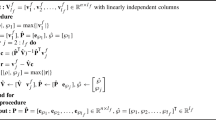Abstract
An adaptation algorithm is developed for radial basis function network (RBFN) in this paper. The RBFN is adapted on-line for both model structure and parameters with measurement data. When the RBFN is used to model a non-linear dynamic system, the structure is adapted to model abrupt change of system operating region, while the weights are adapted to model the incipient time varying parameters. Two new algorithms are proposed for adding new centres while the redundant centres are pruned, which is particularly useful for model-based control. The developed algorithm is evaluated by modelling a numerical example and a chemical reactor rig. The performance is compared with a non-adaptive model.







Similar content being viewed by others
References
Hunt KJ, Sarbaro D, Zbikowsky R, Gawthrop PJ (1992) Neural network for control systems—a survey. Automatica 28(6):1083–1112
Chen S, Billings SA, Grant PM (1992) Recursive hybrid algorithm for non-linear system identification using radial basis function networks. Int J Control 55:1051–1070
Schenker B, Agarwal M (1998) Predictive control of a bench-scale chemical reactor based on neural network models. IEEE Trans Control Syst Technol 6(3):388–400
Chen S, Cowan CFN, Grant PM (1991) Orthogonal least squares learning algorithm for radial basis function networks. IEEE Trans Neural Netw 2:302–309
Karayiannis NB, Mi GW (1997) Growing radial basis networks: merging supervised and unsupervised learning with network growth techniques. IEEE Trans Neural Netw 8(6):1492–1506
Yu DL, Gomm JB, Williams D (1997) A recursive orthogonal least squares algorithm for training RBF networks. Neural Process Lett 5(3):167–176
Luo W, Karim MN, Morris AJ, Martin EB (1996) Control relevant identification of a pH waste water neutralisation process using adaptive radial basis function networks. Comput Chem Eng 20:1017–1022
Gomm JB, Yu DL (2000) Selecting radial basis function network centres with recursive orthogonal least squares training. IEEE Trans Neural Netw 11(3):306–314
Bobrow JE, Murray W (1993) An algorithm for RLS identification of parameters that vary quickly with time. IEEE Trans Autom Control 38(2):35–254
Narendra KS, Parthasarathy K (1990) Identification and control of dynamical systems using neural networks. IEEE Trans Neural Netw 1(1):4–27
Acknowledgments
The project was funded by the U.K. EPSRC with the grant No. GR/N18697.
Author information
Authors and Affiliations
Corresponding author
Appendix
Rights and permissions
About this article
Cite this article
Yu, D.L., Yu, D.W. A new structure adaptation algorithm for RBF networks and its application. Neural Comput & Applic 16, 91–100 (2007). https://doi.org/10.1007/s00521-006-0067-5
Received:
Accepted:
Published:
Issue Date:
DOI: https://doi.org/10.1007/s00521-006-0067-5




